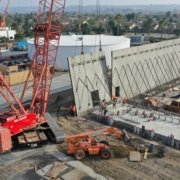Lake Powell Level About to Hit a Historic Low as West’s Water Crisis Deepens
Lake Powell will soon hit its lowest level since Glen Canyon Dam started trapping the Colorado River’s water in 1963 — even with emergency releases of water from reservoirs upstream. The Bureau of Reclamation announced Thursday that the lake elevation will soon drop below 3,555.1 feet above sea level, the record set in 2005, back near the start of a 20-year dry cycle plaguing the Colorado River Basin.











